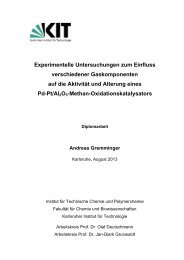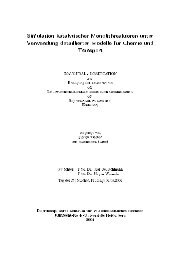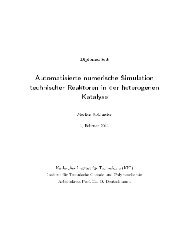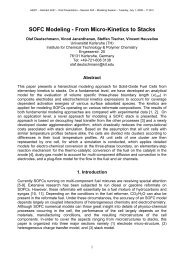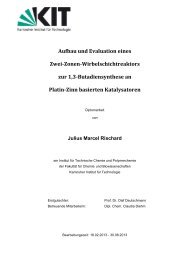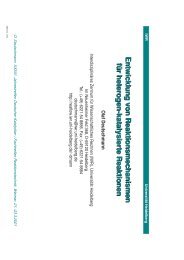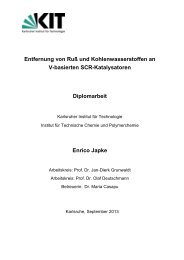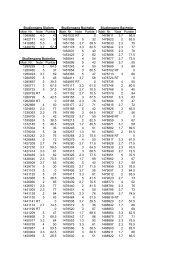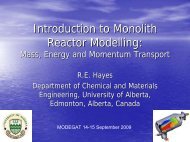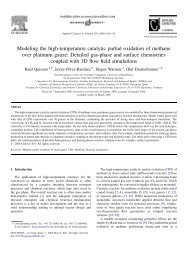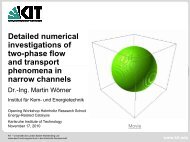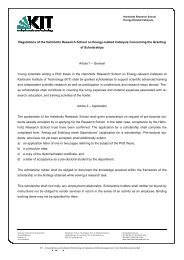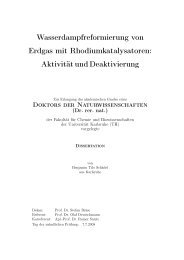Fuel Processing for Fuel Cells - Institut für Technische Chemie und ...
Fuel Processing for Fuel Cells - Institut für Technische Chemie und ...
Fuel Processing for Fuel Cells - Institut für Technische Chemie und ...
You also want an ePaper? Increase the reach of your titles
YUMPU automatically turns print PDFs into web optimized ePapers that Google loves.
Author's personal copy<br />
38 Torsten Kaltschmitt and Olaf Deutschmann<br />
Here, K s is the number of surface reactions, c i are the species concentrations,<br />
which are given, <strong>for</strong> example, in mol m 2 <strong>for</strong> the N s adsorbed<br />
species and in mol m 3 <strong>for</strong> the N g and N b gaseous and bulk species.<br />
The molar net production rate of gas-phase species i, _s i , given in<br />
mol m 2 s 1 , refers to the actual catalytically active surface area, that is,<br />
the (crystal) surface of the catalyst particle, which usually has the size of<br />
1–10 3 nm. These catalyst particles are usually dispersed in a certain structure,<br />
<strong>for</strong> instance, they may occur as dispersed particles on a flat or in a<br />
porous substrate or pellet. The simplest way to account <strong>for</strong> this structure<br />
and the total active catalytic surface area in a reactor simulation is the<br />
scaling of the intrinsic reaction rate at the fluid–solid interphase by two<br />
parameters. The first parameter, F cat/geo , represents the amount of the total<br />
active catalytic surface area in relation to the geometric surface area of the<br />
fluid–solid interphase. Recently, it has been shown that this ratio (F cat/geo )<br />
can also serve as a parameter to describe the dependence of the overall<br />
reaction rate on catalyst loadings and on effects of hydrothermal aging <strong>for</strong><br />
structure-insensitive catalysts (Boll et al., 2010). An alternate representation<br />
of the total catalytic surface area is the volume-specific catalyst surface area,<br />
which is related to the reactor or porous media volume.<br />
The simplest model to include the effect of internal mass transfer<br />
resistance <strong>for</strong> catalysts dispersed in a porous media is the effectiveness<br />
factor, i , based on the Thiele modulus (Hayes and Kolaczkowski, 1997;<br />
Papadias et al., 2000). In case of infinite fast diffusion of reactants and<br />
products in the porous structure, the effectiveness factor becomes unity.<br />
According to Equation (28) and the relation Y i ¼c i s i G 1 , the variations<br />
of surface coverage follow<br />
@Y i<br />
@t ¼ _s is i<br />
G : (29)<br />
Here, the coordination number s i gives the number of surface sites<br />
which are covered by the adsorbed species. Since the binding states of<br />
adsorption of all species vary with the surface coverage, the expression<br />
<strong>for</strong> the rate coefficient, k fk , is commonly extended by coverage-dependent<br />
parameters m ik and e ik (Coltrin et al., 1991; Kee et al., 2003):<br />
Y N s<br />
<br />
k f k<br />
¼ A k T b k<br />
exp<br />
E ak<br />
RT<br />
i¼1<br />
Y m i k<br />
i<br />
exp e i k<br />
Y i<br />
RT<br />
: (30)<br />
Here, A k is the pre-exponential factor, b k is the temperature exponent,<br />
and E ak is the activation energy.<br />
A crucial issue with many of the mechanisms published is thermodynamic<br />
(in)consistency. Even though most of the mechanisms lead to<br />
consistent enthalpy diagrams, many are not consistent regarding the<br />
entropy change in the overall reaction due to lack of knowledge of the



